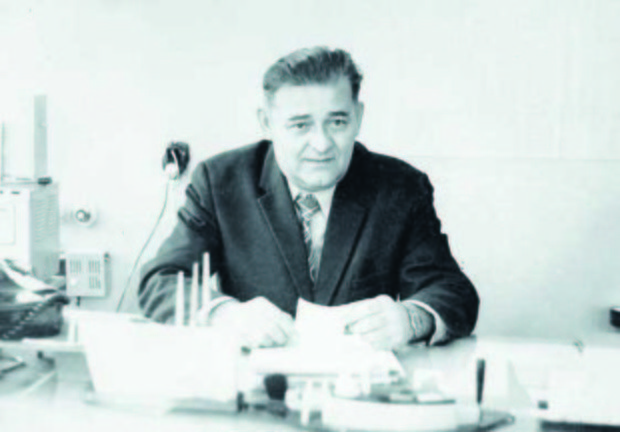Kazan CHPP-3: how one of the biggest heat and power plants of republic developed
The plant is going to celebrate its 50th anniversary of the inclusion in the Russian energy system
The biggest heat and power plant in Kazan, CHPP-3, celebrates its a half-century jubilee this year. 50 years ago, the launch of this plant enabled to provide full-fledged work of new industrial enterprises of the republic and reduce the heat burden from existing generating facilities. Today the Kazan CHPP-3 is a highly-efficient power plant complying with modern-time realities. Its installed electrical capacity is 789,6 MW, heat capacity is 2,390 Gcal/h. And all began in 1968 when the plant was included in the structure of existing heat and power plants in the USSR. Realnoe Vremya tells the details.
In tandem with petrochemistry
In May 1964, the State Power Engineering and Electrification Committee of the USSR approved the task of projecting a new CHP plant in Kazan. The decision to construct was conditioned by the appearance of new enterprises in the northern district of the city, especially the leader of the petrochemical industry Organichesky Sintez factory. The plant-to-be was allocated 101 ha of land next door to the new industrial giant.
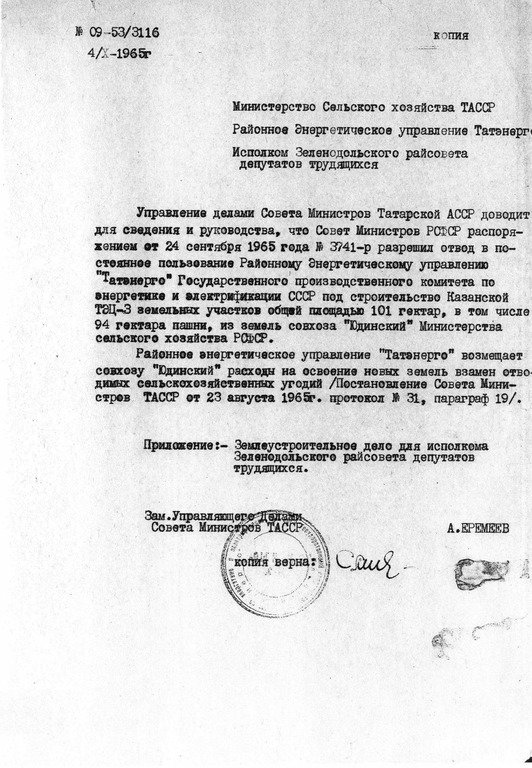
One year later, the project of the Kazan CHPP-3 was elaborated by the Gorky office of the Heat and Power Project All-Union State Design Institute. Fatykh Shagiyev was appointed director of the plant, which was built. Rashit Galiullin became its head engineer.
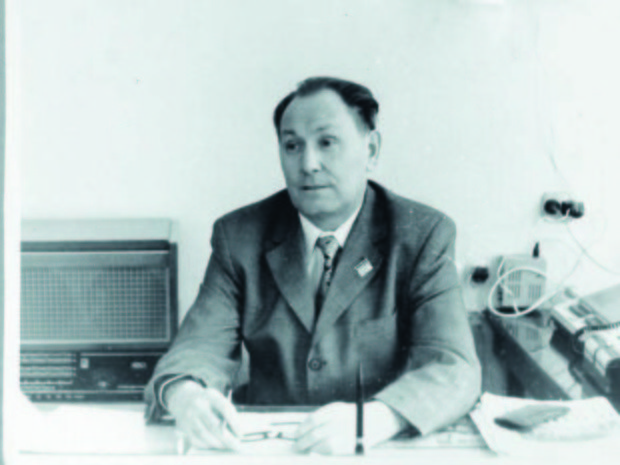
In accordance with the Kazan CHPP-3 construction project, first of all, it was presupposed to construct, install and commission four PTVM-100 peak water heating boilers with a total capacity of 400 Gcal/h.
Fatykh Shagiyev: ''During those years, the republic, especially the capital, faced an enormous deficit of energy. It's enough to say that during peak hours, we often had to switch off the city's lighting and even tramlines. The CHPP-1 and CHPP-2's capacities didn't provide the city's needs for electricity. First of all, I started with acquainting myself with technical documentation or, more precisely, the approved design statement. What I knew just surprised me – low-calorie Kuznetsky coal from Tom-Usinsky field with high humidity and ash content was planned to be the main fuel for the CHPP-3. It was just stupid for the capital of the oil and gas republic! But the Union's State Plan had another opinion. A wall was in front of me. But the CHPP won't run on these coals reliably. I sent a brigade of boiler designers to the Tom-Usinsky Hydroelectric Power Plant to study the boilers running on these coals. They gave officials a report on what they had seen. And coal from the workings located at a distance of 6-40 km came to this HEPP. Even in these conditions, coal in wagons often completely froze, which excluded its mechanised unloading. This HEPP works in complicated conditions with often lasting breaks of boilers to remove slag. And our CHPP, considering the distance of 3,500 km, won't be able to run on these coals. I sat down to write a letter to Moscow. I based on the designer brigade's report, explained the catastrophic deficit of electrical and heat energy capacities in Kazan, tried to explain the economic aspect of the issue and reminded that Kazan was a capital of the oil and gas republic.
Given it all, I gave suggestions:
1. To leave mazut the main fuel in the Kazan CHPP-3.
2. To provide all power plants of the Tatar Republic with fuel oil, to envisage construction of an oil refinery in the republic.
The letter was addressed to none other than Chairman of the Council of Ministers of the USSR A. Kosygin. I realised I jumped the chain of command, I understood the consequences but I put the importance of my business first. It set the wheels in motion. Not immediately, hardly, overcoming numerous obstacles, I managed to shift the Kazan CHPP-3 from coal to mazut!''
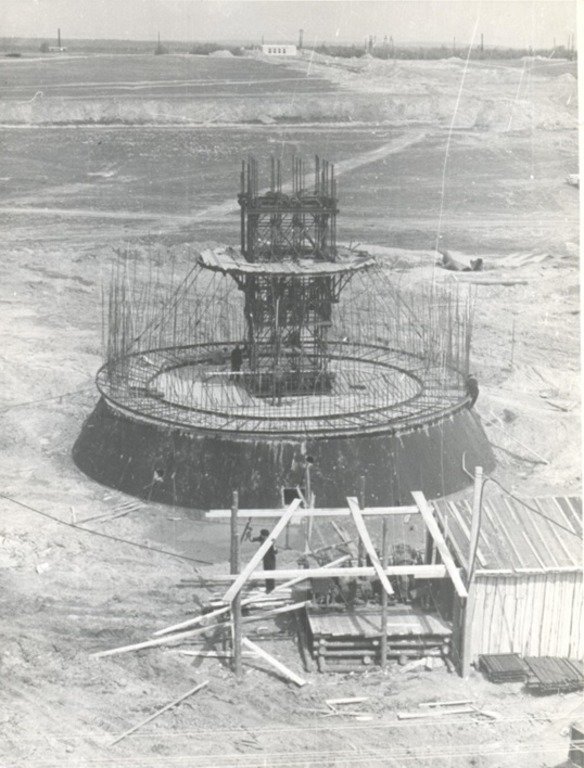
The first three peak water heating boilers were installed and commissioned in December 1967. In January 1968, the plant already was included in the structure of existing heat and power plants in the USSR.
The water heating boiler No. 4 was put into operation on 20 December 1968. The head building was simultaneously built, the preparation for the installation of energy equipment was underway. Heat consumers of the northern district of Kazan started to receive heat from the new CHPP-3. A big work on installation, test and hot water piping flushing preceded the launch of peak boilers.
First alternating current
The launch of the first power boiler and PT-60-130/13 with a capacity of 60 MW with 140 t/h production extraction and pressure of 14 at and heat extraction of 160 t/h and pressure of 1,2 at in January 1971 was the result of a huge job on installation, adjustment and test of different equipment: piping, chemical water treatment, fuel oil handling system, fuel oil piping, feed pumps, deaerators and so on.
The first launch complex was accepted by the state commission in late 1970. A milestone took place on 8 January 1971 – the Kazan CHPP-3 generated its first alternating current. The gradual launch of the equipment of the first stage ended in 1973. The power capacity of the plant reached 260 MW by that time. The Kazan CHPP-3 sent electrical energy through three 110 kW double-circuit lines, which the plant joined with Zelenodolskaya substation, Kazan CHPP-2 and Orgsintez factory with.
In August 1977, after installing gas pipes and gas distribution point (GDP), the Kazan CHPP-3 started to use gas and waste gas of Organichesky Sintez.
The construction of the second stage of the plant began in 1980. Three years later, the KCHPP-3's installed capacity almost doubled and amounted to 440 MW.
A big job on transition of power plants to gas flaring was carried out from 1983. According to the project, which was created by VNIPIenergoprom OKP, a new gas distribution point, two gas pipes with a diameter of 700 mm each were built in the CHPP No. 3. In 1985, the power plant started to flare gas, which became the main fuel, mazut was a reserve. This considerably raised the level and culture of exploitation, reliability and economy of the work of boilers.
Breaking the deadlock
Before 2010, the KCHPP-3 was part of Generating Company PJSC (Tatenergo AO now), then it was acquired by TAIF's TGC-16 PJSC energy company, which was created again.
The goal of the purchase of the energy assets was explicit and almost on the surface. TAIF GC's factories annually had emergency shutdowns due to failures in heat and electricity supplies in the enterprises of Tatarstan's energy system. Meanwhile, TAIF group's enterprises consumed a totality of 50% of generated heat and provided up to 80% of revenue from waste steam heat supply from Generating Company PJSC, which was part of Tatenergo PJSC. Heat tariffs were so high that the share of costs on energy resources in the prime cost of end products of the petrochemical enterprises of TAIF GC was more than 25%. With such a prime cost structure, it was impossible to even think of competitiveness of Tatarstan petrochemical enterprises in the world market. To compare, the share of costs on energy resources in the prime cost of products of analogous enterprises abroad is no more than 5-8% on average. ''This can't go on,'' claimed Director General of TAIF PJSC Albert Shigabutdinov at the year-end meeting of shareholders in 2009. ''We will create our own energy industry from scratch.''

The republic's administration got involved in the situation, which helped to solve all doubtful problems of energy workers and petrochemists extrajudicially. First Tatarstan President Mintimer Shaimiev supported the sale of energy assets to the biggest regional companies – TAIF group and Tatneft group – to create a competitive energy market in Tatarstan and attract financial resources to update generating capacities of the Republic of Tatarstan.
The decision to reform the republic's energy industry by selling three power plants of Generating Company PJSC to big industrial consumers, first of all, was conditioned by the regional officials' care for the population. So the construction of their own energy resources by TAIF group and Tatneft group would lead to almost a closure of the existing power plants in Nizhnekamsk and Kazan and an uncontrollable rise in heating tariffs for these cities' population. On the other hand, the attempt to conserve the situation with high heating tariffs for industrial enterprises, which arose at that moment, would bring to a shutdown of petrochemical enterprises and oil refineries, they would stop consuming heat energy, which also might negatively affect the tariffs for the population and general social and economic situation in the republic. In this situation, which seemed to be deadlock, there was chosen an option that considered, first of all, interests of the population of the Republic of Tatarstan. Though it was less effective for the new owners, from a perspective of capital intensity and payback of invested money.
The power plants' sale price was set based on the market-value appraisal, which was carried out by authoritative foreign experts and approved by the republic's government.
Integrated update
Having become the owner of the energy assets, TAIF started to create a strategic programme to increase the reliability and effectiveness of the energy complex by updating it.
In the Kazan CHPP-3, the process included several stages. The measures aimed to provide the factory's reliable electricity and heat energy generation were taken first. Then a stage of an integrated reconstruction and upgrade of the power plant to increase the effectiveness and competitiveness of energy production started. The construction of a gas turbine power unit, which was based on the unique 9HA.01 gas turbine made by General Electric, was the biggest measure. Nowadays Russia doesn't have analogues of this turbine. Right its commissioning became the final accord of the integrated update programme of the Kazan CHPP-3.

A 405,6 MW power unit was launched in the KCHPP-3 in June 2017. This can rightly be called one of the most important events for the Tatarstan electrical energy industry. The construction price for one kW of installed capacity was €535. As a result, electrical energy in combined cycle of the plant almost tripled. In addition, brake specific fuel consumption per supplied electrical energy (indicates a plant's effectiveness) reduced in the Kazan CHPP-3 from 310 g/kWh to 244,2 g/kWh (as from 2017).
''It's the biggest gas turbine unit in our country. It's a very serious step and a good example,'' said Tatarstan President Rustam Minnikhanov at the opening.
Kazan energy ring's pivot
In the end, it was possible to erect the power unit in 1,5 years. According to Director General of TAIF PJSC Albert Shigabutdinov, the total price for the project was 14bn rubles. Sberbank CIB financed the major part of the project with the participation of Bank Tatarstan of Sberbank's Volga-Vyatka bank.
The end of the construction and launch of the turbine marked the completion of the update of the Kazan CHPP-3. So the plant became the second pivot of the creation of the 220 kW energy ring around Kazan. All three sources are interlinked with each other by 220 kW lines, through which they can transmit a reserved capacity in case of a local deficit or shutdown. And this means the population and industrial enterprises will be provided with reliable energy supply.
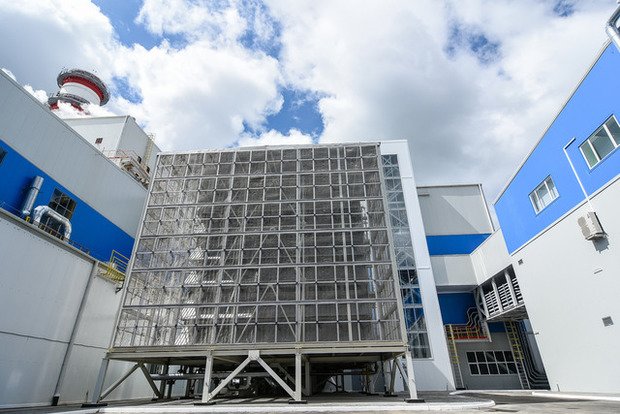
The new power unit reduced the deficit of electrical capacity in the Kazan energy district. The GTU's advantage is its flexibility. Quick start, quick load increase, high reliability and high effectiveness are key indicators for electrical power engineering. The unique turbine is linked to the steam turbine equipment, which already exists in the power plant. Thanks to it, the CHPP generates electrical energy and heat on the basis of a steam gas cycle after putting the gas turbine unit into operation.
Among the GTU's advantages, we also need to notice its high manoeuvrability in use, which is achieved by applying innovative unit management system, which, in turn, enables to quickly launch the unit, switch to partial load with the conservation of high effectiveness indicators.
TGC-16's representatives notice that turbine is eco-friendly. The power unit has a low-emission combustion camera, which allows the Kazan CHP-3 significantly reduce emissions into the environment.
''We invested a lot of effort and energy in this project. Our power unit became the first in Russia and second in the world (the first such a turbine was installed in France). Moreover, according to test results, we managed to get higher parameters of the power unit than installed. Instead of mentioned 389 MW in the contract, the gas turbine's load is 405 MW on average. While adjusting, at corresponding temperatures of external air, the GTU's capacities reached 425 MW. What gladdens is that technical and economic parameters of the GTU are stable and comply with all norms and technical conditions,'' Director General of TGC-16 Eduard Galeyev proudly claims and adds that the period of ''infantile diseases'' turned out to be short. Now the machine runs reliably.
''We need to do justice to GE, our unit is under constant supervision of the company's engineering centre working round the clock. General Electric specialists solve any arising problems as fast as possible,'' Galeyev tells.
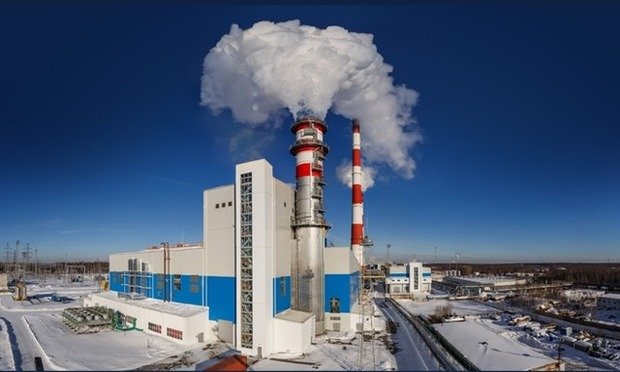
Meanwhile, energy workers forecast that if they were late to launch the project, the situation in the KCHPP-3 would be quite uneasy. The case is that electrical energy prices in the wholesale electrical energy market (WEEM) in 2017 suddenly dropped. It's linked to the implementation of new effective capacities in Russia's energy system and lasting freshet. The freshet was continuous and ended, in fact, only in August. As a consequence, the share of hydroelectric power plants' electric energy generation grew. And the price in the WEEM decreased by 100 rubles per MW/h on average during this period. Without the highly-effective generating capacity, the KCHPP-3 would find it hard to provide its competitiveness in the MEEM.
New height
Today the CHPP-3 is the biggest electrical energy power plant in Kazan. Its installed electrical capacity is 789,6 MW, heat capacity is 2,390 Gcal/h. The KCHPP-3's heating tariffs are the lowest in Kazan among big generation and one of the lowest across Tatarstan. For instance, an average tariff on the Kazan CHPP-3's heating is 603 rubles/Gcal, while a tariff on heating supplied by Tatenergo AO's sources is 801 rubles/Gcal.
The production successes would be unimaginable without the targeted social support of plant workers. Working places have good conditions for work and rest. TGC-16's integrated programme to support physical culture and sport is actively fulfilled in the plant. The CHPP-3 annually holds multidisciplinary sports events among its divisions.
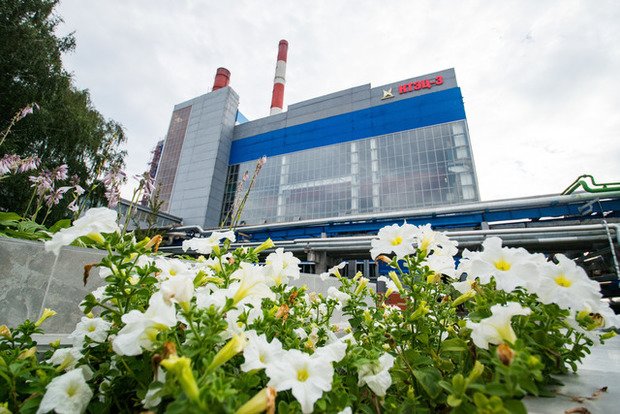
Taking care of the environment, the Kazan CHPP-3 gives much importance to environmental protection and pursues an effective ecological policy by optimising production processes, taking energy-saving measures, implementing advanced technologies and rational resource consumption. So the plant's employees created and agreed the ''Plan For Environmental Protection Activities on Rational Use of Water Resources and Protection of Water Bodies''. The construction of storm and industrial wastewater treatment plants became one of the key points of the document. The set of measures is aimed to reduce Volga water consumption by returning treated water to the plant's production cycle. At this moment, there is a sewage pump plant, coalescence and sorption unit, UPRF-100 flotation unit.
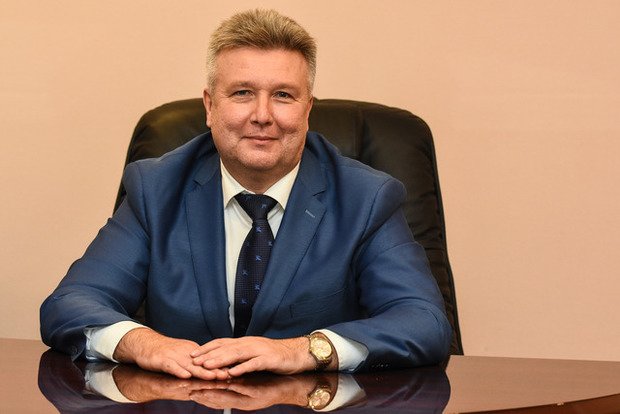
The Kazan CHPP-3 doesn't stay still: the plant was one of the first pilot platforms in Tatarstan to implement Industry 4.0 concept. Within the update, General Electric installed Predix system that serves to track and forecast technical failures. This platform also enables to minimise possible shutdowns of equipment due to technical failures.
''Having reliable foundation to develop and multiply the results that were achieved, the Kazan CHPP-3 will continue making Tatarstan's life more comfortable and favourable. Over the years of its stable and quality work, the plant has deserved the reputation of one of the most reliable heat and electrical energy suppliers in the region. The persistent continuity of generations of energy workers, transmission of professional experience to the young generation by veterans is a recipe for successful work,'' concludes Director General of TGC-16 Eduard Galeyev.
